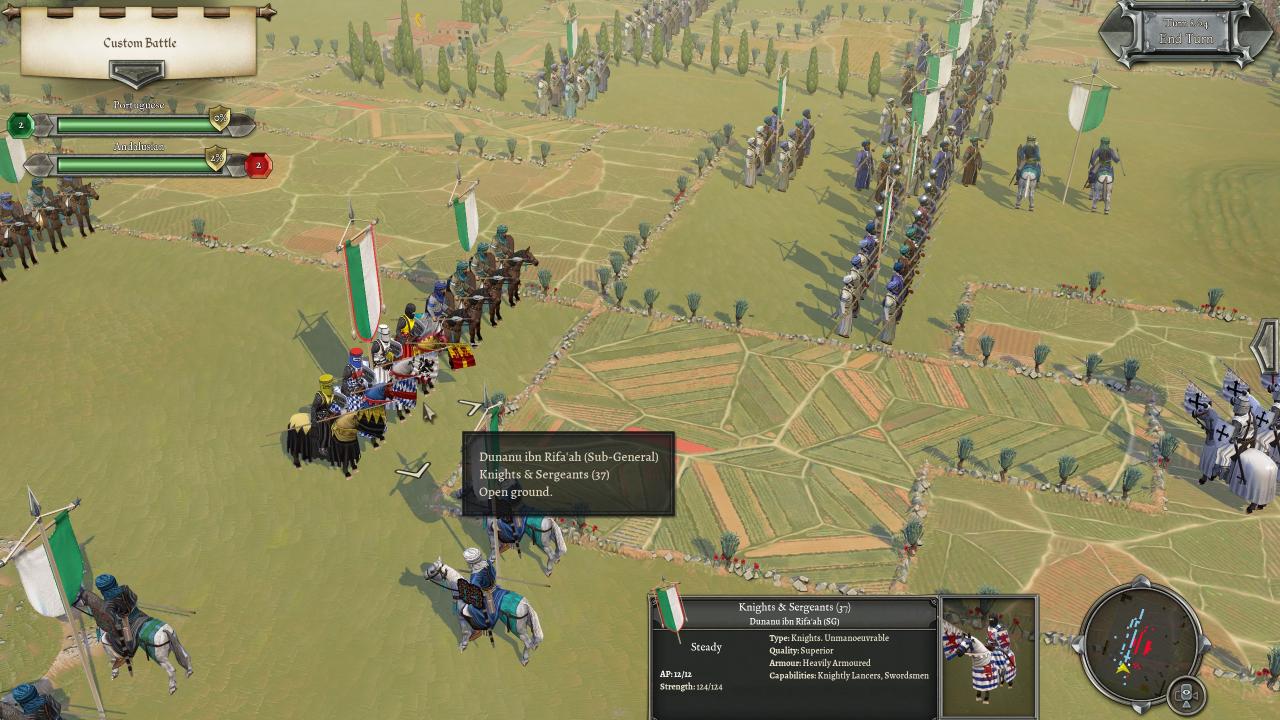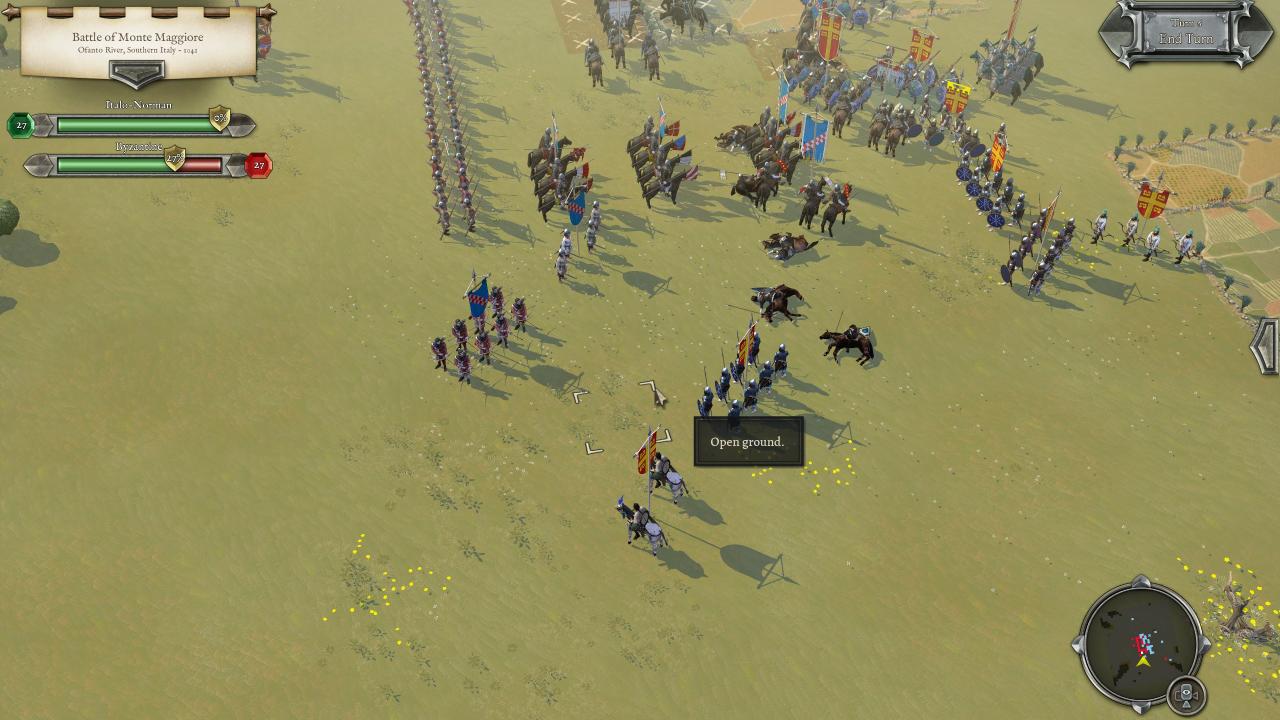Field of Glory II – Medieval Reconquista is a new venture from Byzantine Games that takes the same formula as Field of Glory II : Medieval and adapts it to the later years of the medievo era.
To avoid misinterpretation and mistakes, I will disclaim having graduated in history. The medieval period, mainly the systems of law and nature of warfare, holds a special place in my hearts. Let’s take a look how well FoG II does as a videogame and, most importantly, how well it portrays medieval warfare.
Medieval warfare, to be honest, was a far cry away from the grandiose wars of the Ancient Period (or Classical Period). A couple of thousand poorly armed warriors, or more commonly, a few hundred, led by a dozen Knights, would make small incursions to neighbouring lands in order to pillage what they could. This unfortunate reality would not make for a good game or spectacle. In the late middle ages, armies became semi-professional. They were given formal training, disciplined, and instilled with a sense collective interest and nationalism. Do not be mistaken, peasants and small businessmen, as well as craftsmen, had no interest whatsoever in the petty matters of Dukes, barons, and kings. In some parts of Europe, it was not uncommon for them to boycott or expose violent behavior. Everyone agrees, after studying the historical records on medieval “Cortes”, that urban and rural militia played a major role in medieval society. Portuguese Cortes is, for lack of a more appropriate term, an occasion where the King invites noblemen, clergymen, and representatives of common folk to express their worries, problems, and concerns. After deliberation, the statement would be made into law. Why is this important for warfare? It is because we can establish a strong connection between the urban milices and the king of the day.
The split between the north and south of Mediterranean was also evident in the military, where the Christian and Arabic armies differed greatly. Christian commanders were depicted in medieval enluminures as using medium to heavy cavalry as shock troops or flanking forces. The Arabs, on the other hand, used light and medium cavalry with great success up until the 10th century. However they rarely did so afterward. The archetype of their mounted forces was mainly made up of lightly armored cavalry, whose main goal was to force an enemy into multiple engagements over a long period of time. Although they can flank and harass their enemy, it was never intended that they be used as shock troops. This will work in favor of the Christians later. In the area of ranged weapons there was another significant difference. Muslims used crossbows very rarely, and only in a few cases in the Peninsula. They preferred to use regular, massed archers who used small-to-medium poundage bows.

The power struggle over the fate of the peninsula is about to start in the early 11th Century. The Emirate Cordoba, weakened by internal fighting, has collapsed under the weight of its own success. The local Muslim rulers are now struggling to gather forces against the Christian invasion called Reconquista. The DLC begins here, and players will be fighting tooth and nail between the 12th and early 14th centuries to determine the fate of Southern Europe.
FoG 2 has a lot of randomness in it, and it is lovely. I have become accustomed to the RNG and find it fascinating. I also think it’s necessary to maintain that element of What if. What would have happened if instead of charging-on its own!- another army, your general had not charged and the outcome was different? How about snatching a victory from the jaws of defeat? What would happen if you were able to cut down the enemy’s strength and unity by only 30 men, instead of killing them with your archers? What happens if the enemy spearmen who are resilient lose an 80% win melee? They will be weakened to the point where they’ll finally be beaten. These What ifs can lead to memorable and crucial moments.
History shows that large formations are difficult to maneuver, and can be even more difficult to control during battle. FoG simulates this as well by having certain units march ahead and turn while they march, then turn to their flanks where they are standing.
I’m not going to leave the complaint box empty, but the absence of nation-specific units has made me itch: Where are the Portuguese “Besteiros de Conto”, one of the earliest instances of a professionalcorps that were mandated by law, to train with a crossbow, keep horses, and be equipped and ready for battle? Byzantine Games deserves a second chance because the Portuguese are known for their mounted crossbowmen. Historical accounts also mention that the professional crossbowmen were required to own a horse. Crossbowmen and archers have a very limited impact. They can only fire a few times before they’re trampled by cavalry, or are permanently locked in stalemate.
The Reconquista DLC will have an average of 150 units and around the same amount of army lists. That’s a ton to play with.
It will make some interesting moves, such as kiting and flanking. It will only engage in battles it can win. It won’t just move forward blindly. It is serviceable and will fight.

The Editor and Campaigns
The premade campaigns are not my favorite and I am not interested in creating my own. I can create a Sandbox Campaign that allows me to choose which nation I would like to use for a specific number of battles. FoG II has a huge toolbox for creating your own scenarios. Editors are essential to replayability. With the huge amount of army and unit lists, and the simple scenario editor, you can easily recreate the medieval battles you want. Setting up a customized battle shouldn’t take more than a couple of minutes.
The Steam page features the following game:
- There are 20 additional nations and groups covering Spain, Italy, and North Africa between 1040 AD and 1270 AD. There are Andalusians as well as Almohads and Arabs. Also included are the Byzantine Catapanate, Catalans/Castilians/Leonese of Italy, Granadines/Leonese of Spain, Catalans/Castilians/Leonese of Italy, Italian Guelfs/Italian Ghibellines/Italian Ghibellines/Italians/Italo-Normans/Lombards Each has its own historically accurate flag.
- The 41 additional units will allow the troops from all the new factions be accurately represented.
- The addition of 45 new army lists allows for historically realistic armies to be created by each of the factions above and their allies, at different dates in the period. This brings the total number Medieval army list up to 103. Moreover, armies may include contingents of historical allies. There are more than 50 000 possible combinations. There are always new combinations to try.
- Eight more epic historical scenarios that cover key battles during the period. These include Monte Maggiore 1041, Civitate 1053, Cabra 1079, Sagrajas 1086, Legnano 1176, Las Navas De Tolosa 1212, Montaperti 1260 and Benevento 1266.
- Quick Battle now includes 33 additional historical matchups, bringing the total number of playable matches to 98.
- Four more historical campaigns are available, covering the major leaders of the era and their conflicts: El Cid; Muhammad II of Granada; Normans in South Africa and Frederick II Hohenstaufen.
- The Sandbox campaign has been expanded to include the entire new army list, which allows you to play as any nation and their historical allies against any other nation. This gives thousands of different combinations.